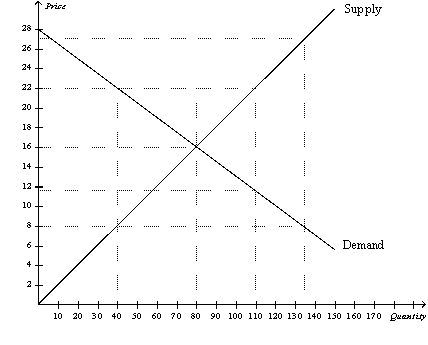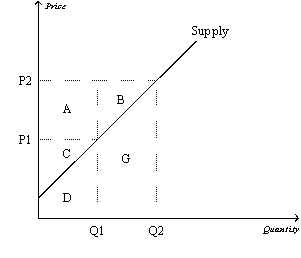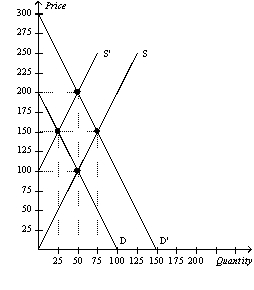A) producer surplus.
B) producer deficit.
C) cost of building fences.
D) profit.
F) All of the above
Correct Answer

verified
Correct Answer
verified
Multiple Choice
Which of the following will cause an increase in consumer surplus?
A) an increase in the production cost of the good
B) a technological improvement in the production of the good
C) a decrease in the number of sellers of the good
D) the imposition of a binding price floor in the market
F) A) and D)
Correct Answer

verified
Correct Answer
verified
True/False
Welfare economics is the study of the welfare system.
B) False
Correct Answer

verified
Correct Answer
verified
Multiple Choice
Brock is willing to pay $400 for a new suit,but he is able to buy the suit for $350.His consumer surplus is
A) $50.
B) $150.
C) $350.
D) $400.
F) A) and C)
Correct Answer

verified
Correct Answer
verified
Multiple Choice
Table 7-1
 -Refer to Table 7-1.If the price of the product is $22,then who would be willing to purchase the product?
-Refer to Table 7-1.If the price of the product is $22,then who would be willing to purchase the product?
A) Lori
B) Lori and Audrey
C) Lori,Audrey,and Zach
D) Lori,Audrey,Zach,and Calvin
F) A) and D)
Correct Answer

verified
Correct Answer
verified
Multiple Choice
Figure 7-18  -Refer to Figure 7-18.If 40 units of the good are being bought and sold,then
-Refer to Figure 7-18.If 40 units of the good are being bought and sold,then
A) the marginal cost to sellers is equal to the marginal value to buyers.
B) the marginal value to buyers is greater than the marginal cost to sellers.
C) the marginal cost to sellers is greater than the marginal value to buyers.
D) producer surplus would be greater than consumer surplus.
F) A) and B)
Correct Answer

verified
Correct Answer
verified
Multiple Choice
Figure 7-12  -Refer to Figure 7-12.Area B represents
-Refer to Figure 7-12.Area B represents
A) the combined profits of all producers when the price is P2.
B) the increase in producer surplus to all producers as the result of an increase in the price from P1 to P2.
C) producer surplus to new producers entering the market as the result of an increase in the price from P1 to P2.
D) that portion of the increase in producer surplus that is offset by a loss in consumer surplus when the price increases from P1 to P2.
F) All of the above
Correct Answer

verified
Correct Answer
verified
Multiple Choice
Table 7-8
The only four producers in a market have the following costs:
 -Refer to Table 7-8.If the sellers bid against each other for the right to sell the good to a consumer,then the producer surplus will be
-Refer to Table 7-8.If the sellers bid against each other for the right to sell the good to a consumer,then the producer surplus will be
A) $0 or slightly more.
B) $50 or slightly less.
C) $150 or slightly less.
D) $200 or slightly more.
F) A) and C)
Correct Answer

verified
Correct Answer
verified
Multiple Choice
Michael values a stainless steel refrigerator for his new house at $3,500,but he succeeds in buying one for $3,000.Michael's willingness to pay is
A) $500.
B) $3,000.
C) $3,500.
D) $6,500.
F) A) and C)
Correct Answer

verified
Correct Answer
verified
Multiple Choice
Which of the following statements is not correct?
A) A seller would be eager to sell her product at a price higher than her cost.
B) A seller would refuse to sell her product at a price lower than her cost.
C) A seller would be indifferent about selling her product at a price equal to her cost.
D) Since sellers cannot set the price for their product,they must be willing to sell their product at any price.
F) B) and C)
Correct Answer

verified
Correct Answer
verified
Multiple Choice
Suppose that Firms A and B each produce high-resolution computer monitors,but Firm A can do so at a lower cost.Cassie and David each want to purchase a high-resolution computer monitor,but David is willing to pay more than Cassie.Which of the following market outcomes is efficient?
A) Firm A produces a monitor that Cassie buys.David does not purchase a monitor.
B) Firm A produces a monitor that David buys.
C) Firm B produces a monitor that Cassie buys.David does not purchase a monitor.
D) Firm B produces a monitor that David buys.
F) B) and C)
Correct Answer

verified
Correct Answer
verified
Multiple Choice
An example of positive analysis is studying
A) how market forces produce equilibrium.
B) whether equilibrium outcomes are fair.
C) whether equilibrium outcomes are socially desirable.
D) if income distributions are fair.
F) C) and D)
Correct Answer

verified
Correct Answer
verified
Multiple Choice
Market power and externalities are examples of
A) laissez-faire economics.
B) public policy.
C) market failure.
D) welfare economics.
F) A) and C)
Correct Answer

verified
Correct Answer
verified
True/False
Producer surplus is the cost of production minus the amount a seller is paid.
B) False
Correct Answer

verified
Correct Answer
verified
True/False
Each seller of a product is willing to sell as long as the price he or she can receive is greater than the opportunity cost of producing the product.
B) False
Correct Answer

verified
Correct Answer
verified
Multiple Choice
Total surplus is represented by the area
A) under the demand curve and above the price.
B) above the supply curve and up to the price.
C) under the supply curve and up to the price.
D) between the demand and supply curves up to the point of equilibrium.
F) A) and D)
Correct Answer

verified
Correct Answer
verified
Multiple Choice
If a consumer is willing and able to pay $20 for a particular good and if he pays $16 for the good,then for that consumer,consumer surplus amounts to
A) $4.
B) $16.
C) $20.
D) $36.
F) A) and D)
Correct Answer

verified
Correct Answer
verified
Multiple Choice
Consumer surplus is
A) the amount a buyer is willing to pay for a good minus the amount the buyer actually pays for it.
B) the amount a buyer is willing to pay for a good minus the cost of producing the good.
C) the amount by which the quantity supplied of a good exceeds the quantity demanded of the good.
D) a buyer's willingness to pay for a good plus the price of the good.
F) All of the above
Correct Answer

verified
Correct Answer
verified
Multiple Choice
Figure 7-9  -Refer to Figure 7-9.If the demand curve is D and the supply curve shifts from S' to S,what is the change in producer surplus?
-Refer to Figure 7-9.If the demand curve is D and the supply curve shifts from S' to S,what is the change in producer surplus?
A) Producer surplus increases by $625.
B) Producer surplus increases by $1,875.
C) Producer surplus decreases by $625.
D) Producer surplus decreases by $1,875.
F) A) and C)
Correct Answer

verified
Correct Answer
verified
Multiple Choice
A result of welfare economics is that the equilibrium price of a product is considered to be the best price because it
A) maximizes both the total revenue for firms and the quantity supplied of the product.
B) maximizes the combined welfare of buyers and sellers.
C) minimizes costs and maximizes output.
D) minimizes the level of welfare payments.
F) B) and D)
Correct Answer

verified
Correct Answer
verified
Showing 61 - 80 of 455
Related Exams